7 Condition-Based Maintenance Mobile Applications
This chapter discusses these topics:
-
Section 7.1, "Condition-Based Maintenance Mobile Applications Overview"
-
Section 7.2, "Setting Up the Condition-Based Maintenance Mobile Applications"
-
Section 7.3, "Using the Condition-Based Maintenance Mobile Tablet Application"
-
Section 7.4, "Using the Condition-Based Maintenance Mobile Smartphone Application"
|
Important Note: Before using the mobile applications, Oracle strongly recommends that users have a complete understanding of how to use the associated processes and applications in the JD Edwards EnterpriseOne base software.For additional information about the processes and applications associated with the mobile applications discussed in this chapter, see:
|
7.1 Condition-Based Maintenance Mobile Applications Overview
You use the Condition-Based Maintenance mobile applications to review condition-based alert messages, and to manually enter or update alerts from within the JD Edwards EnterpriseOne system. You can use the Condition-Based Maintenance mobile applications to:
-
Add important alert information, including media objects that contain time stamps.
-
Send a notification alert message manually or automatically to those who need instant notification of critical equipment status, such as technicians, supervisors, or a distribution list.
-
Respond to the alerts. When the system receives an equipment alert, you can send an investigation message to one person, such as a plant technician or supervisor, or to a distribution list, to begin the investigation process. You can then generate a work order or update the preventive maintenance schedule, based on the setup parameters for condition-based maintenance. You can respond to alerts manually or automatically by setting up alert action rules. The responses available for condition-based alerts include:
-
Initiating an investigation request
-
Creating a work order to inspect, repair, or replace the cause of the alert
-
Updating the preventive maintenance schedule
-
This table lists the applications that are available to review, enter, or modify the condition-based maintenance alerts:
| Type of Application | Additional Information |
|---|---|
| Base EnterpriseOne application | Use these applications in the JD Edwards EnterpriseOne system to work with condition-based maintenance alerts:
|
| Tablet application | Condition-Based Maintenance (M13101)
To download the application to your tablet, search on the following text in the application store:
|
| Smartphone application | Condition-Based Maintenance (M13102)
To download the smartphone application to your smartphone, search on the following text in the application store:
|
Before using the Condition-Based Maintenance tablet or smartphone application, you should first set the processing options for each application.
7.1.1 Differences and Limitations: Condition-Based Maintenance
Mobile applications are intended to be a simplified version of the applications that are available in the base software. In most cases, these applications provide a subset of the functionality available in the base software.
The Condition-Based Maintenance tablet and smartphone mobile applications allow mobile users to review only open alerts by default. However, users can explicitly specify if they want to review the closed status records also.
Language Support
Additionally, you should be aware of how a user's language preference can affect the search functionality for business unit and branch/plant records. See Section 1.2.2.1, "Language Support for Business Unit and Branch Plant Searches"
Barcode Scanning (Release 9.1 Update)
The Condition-Based Maintenance mobile tablet application (M13101) and the Condition-Based Maintenance mobile smartphone application (M13102) are designed to scan data from a barcode and populate the equipment number in the Equipment Number field. To scan barcode data, you can use the native camera on your device or a third-party handheld Bluetooth-enabled scanning device. To use this functionality, you must create barcodes that represent a single field in the JD Edwards EnterpriseOne system. This application does not accept barcodes that consist of data for multiple fields.
You can generate barcodes using services such as those offered by Barcodes Inc.
|
Note: Oracle is not affiliated with Barcodes, Inc. and does not require or recommend that you use this service to create your barcodes. |
7.2 Setting Up the Condition-Based Maintenance Mobile Applications
Before using the Condition-Based Maintenance mobile applications, verify that the processing options for each application are set correctly. The processing options for both the tablet and the smartphone applications specify which versions of the base EnterpriseOne applications the mobile applications use.
These are the setup tasks that you should complete before using the mobile applications:
-
Review processing options for the Condition-Based Alerts Workbench (P1310) application. See Setting Processing Options for Condition-Based Alerts Workbench (P1310).
-
Review processing options for the Condition-Based Alerts Revision (P1311) application. See Setting Processing Options for Condition-Based Alerts Revision (P1311).
-
Set processing options for the Condition-Based Maintenance mobile applications (M13101 and M13102).
(Release 9.1 Update) You can use one of the following options to scan barcodes of equipment number:
-
Disable the Bluetooth option in the settings on your device if you want to use the native device camera to scan the barcodes of equipment number.
-
Enable the Bluetooth option if you want to use a Bluetooth-enabled scanning device to scan the barcodes of equipment number.
To scan barcodes using the Bluetooth scanning device, you must configure the scanning device to the mobile device.
7.2.1 Setting Processing Options for the Condition-Based Maintenance Mobile Tablet Application (M13101)
You use processing options to specify default processing information for a program.
7.2.1.1 Versions
- 1. Condition-Based Alerts Workbench (P1310) Version
-
Use this processing option to specify which version of the Condition-Based Alerts Workbench program the mobile application uses to determine default values while working with condition-based alerts. If you leave this option blank, the application uses version ZJDE0001.
- 2. Condition-Based Alert Revisions (P1311) Version
-
Use this processing option to specify which version of the Condition-Based Alert Revisions program the mobile application uses to determine default values while working with condition-based alerts. If you leave this option blank, the application uses version ZJDE0001.
7.2.2 Setting Processing Options for the Condition-Based Maintenance Mobile Smartphone Application (M13102)
You use processing options to specify default processing information for a program.
7.2.2.1 Versions
- 1. Condition-Based Alerts Workbench (P1310) Version
-
Use this processing option to specify which version of the Condition-Based Alerts Workbench program the mobile application uses to determine default values while working with condition-based alerts. If you leave this option blank, the application uses version ZJDE0001.
- 2. Condition-Based Alert Revisions (P1311) Version
-
Use this processing option to specify which version of the Condition-Based Alert Revisions program the mobile application uses to determine default values while working with condition-based alerts. If you leave this option blank, the application uses version ZJDE0001.
7.2.3 Setting Up the Bluetooth Option in the Mobile Device to Scan Barcodes (Release 9.1 Update)
The Condition-Based Maintenance mobile tablet application (M13101) and the Condition-Based Maintenance mobile smartphone application (M13102) include the Equipment Number field in three locations in the application. One is in the filter screen. Another location displays when you choose any existing conditioned-based alert record; the Equipment Number field displays when you select the Alert Details tab in the Condition-Based Maintenance Alert screen for tablet and in the Displays screen for smartphone. The third location displays when you add a new conditioned-based alert; the Equipment Number field displays when you select the Alert Details tab in the Condition-Based Maintenance Alert screen for tablet and in the Displays screen for smartphone. You use the Equipment Number filter to filter records by equipment number. You can modify the equipment number of a conditioned-based alert record in the Equipment Number field that is displayed in the Alert Details screen. When you create a new conditioned-based alert using the Condition-Based Maintenance tablet and smartphone applications, you must enter the equipment number in the Equipment Number field.
You can populate the Equipment Number field (in the filter screen, in the Alert Details screen of any existing conditioned-based alert record, as well as in the add new conditioned-based alert screen) using the following options:
-
Use the keyboard on your mobile device to manually enter the data.
-
Use the camera application on your mobile device to scan the data. To use this option, you must disable the Bluetooth option in your device settings.
-
Use a Bluetooth-enabled scanning device to scan the data. To use this option, you must:
-
Enable the Bluetooth option in your device settings.
-
Configure the third-party scanning device to connect to your mobile device.
Note:
When you enable the Bluetooth option on your device, the system may disable the device's keyboard. -
7.3 Using the Condition-Based Maintenance Mobile Tablet Application
The Condition-Based Maintenance tablet application enables you to:
-
Review condition-based alert messages.
-
Add important alert information.
-
Send notification alert messages.
-
Add or delete photos for alerts.
-
Add notes for alerts.
Before you can use the application, you must download and install the application from the application store on your device.
7.3.1 Reviewing and Updating Condition-Based Alerts Using a Mobile Tablet
To review and update condition-based maintenance alerts:
-
Open the application by tapping the CBM Alert icon on your device, and then log in.
See Chapter 3, "Logging Into Mobile Enterprise Applications"
-
The device displays the Condition-Based Maintenance Alert screen with the list of all open status alerts with details, such as alert description, equipment number and description, alert level number and description, alert status and description, and unit number in the left pane. The device displays the details of the first record in the right pane of the screen.
To narrow your search using the filter fields, tap the Filter button, and specify values in these fields on the Filters screen:
Closed Status Alerts
Technician
Customer Number
Location
Site Number
Equipment Number (Release 9.1 Update) - This field retrieves the equipment list based on the equipment number. Enter data in the Equipment Number field using one of these options:
-
Use the keyboard on your mobile device to manually enter the data. Alternately, you can tap the search and select button to search and select a piece of equipment.
-
Use the camera application on your mobile device to scan the data.
To use this option, tap the QR Code button next to the Equipment Number field. The system launches the device camera and you can scan the barcode of the equipment.
-
Use a Bluetooth-enabled scanning device to scan the data.
To use this option, tap the Equipment Number field to activate the scanning device. Then, scan the barcode of the equipment using the scanning device.
Note:
The Equipment Number field is designed to accept the asset that you identify with an identification symbol in the Fixed Assets Constants program (P001012).See Setting Up Fixed Asset Constants in the JD Edwards EnterpriseOne Applications Fixed Assets Implementation Guide.
For example, if the symbol to identify the serial number is "/" and the serial number is "4CE0460D0G"; then you need to enter "/4CE0460D0G" in the Equipment Number field to search and select a piece of equipment.
-
-
In the Filters pane, to continue the search using the specified filter values, tap the Apply button. When you tap the Apply button, the device:
-
Takes you to the list of maintenance alerts that are displayed based on your filter values.
-
Saves the filter values that you entered. The system displays the saved filter values the next time you open the filter screen.
To discontinue the use of filter values in your search, tap the Cancel button. When you tap the Cancel button, the device:
-
Takes you to the Condition-Based Maintenance Alert screen associated with the last saved filter values, if applicable.
-
Ignores the filter values that you entered, and restores the last saved filter values to the filter fields.
To delete all filter values you specified, and to enter new filter values, tap the Clear button.
-
-
The system returns you to the Condition-Based Maintenance Alert screen with a list of condition-based alerts that meet your search criteria. The first record is automatically selected, and details associated with that record are displayed on the right side of the screen.
Tap any record in the list to review the details for that record.
-
On the Alert Details tab, review and modify the alert details. Tap the Save button at the top right to save any changes you make on this tab.
Figure 7-1 Condition-Based Maintenance - Alert Details Tab
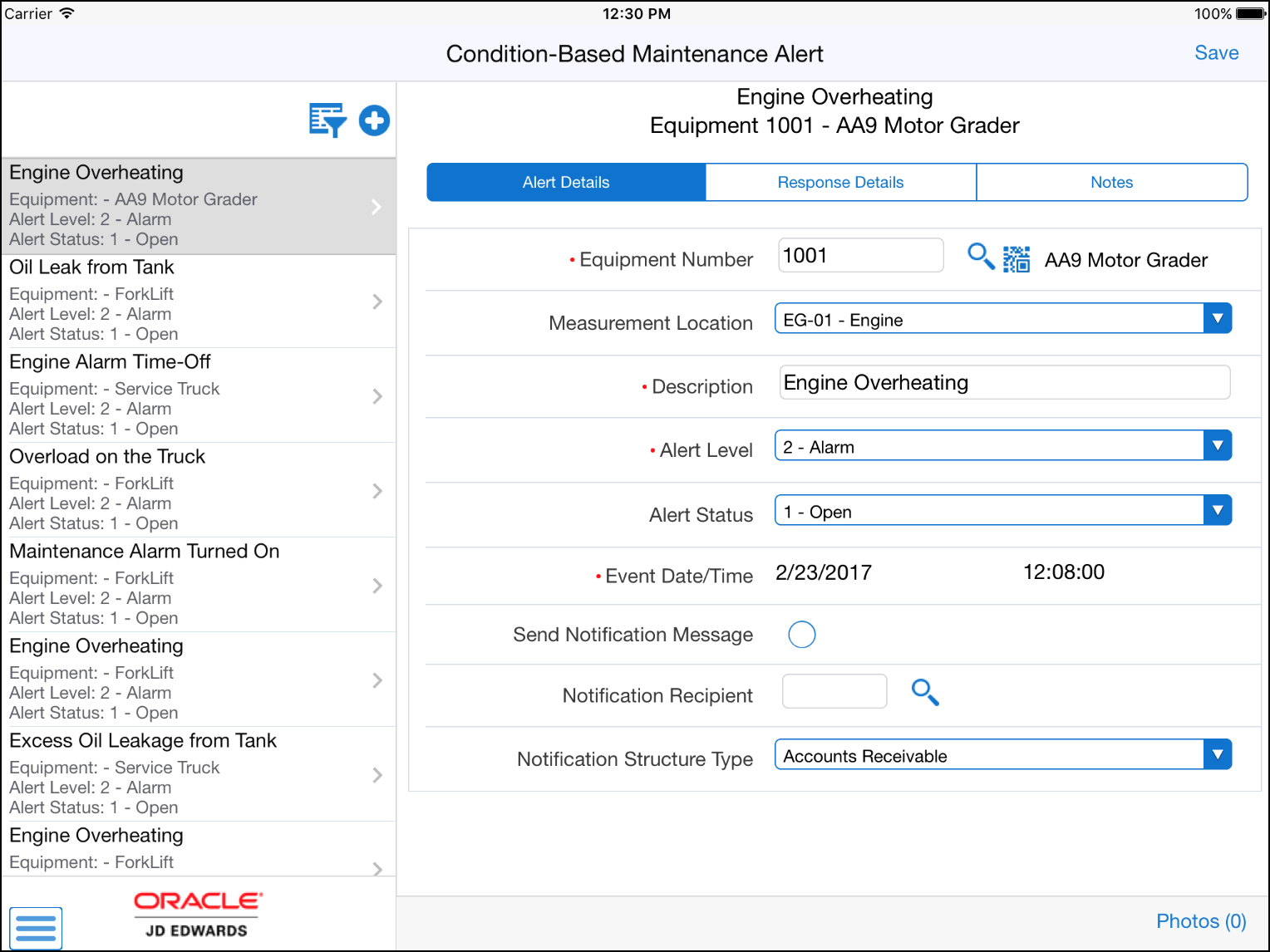
Description of ''Figure 7-1 Condition-Based Maintenance - Alert Details Tab''
-
Tap the Response Details tab to review or update response details for the alert. Tap the Save button at the top right to save any changes you make on this tab.
Figure 7-2 Condition-Based Maintenance - Response Details Tab
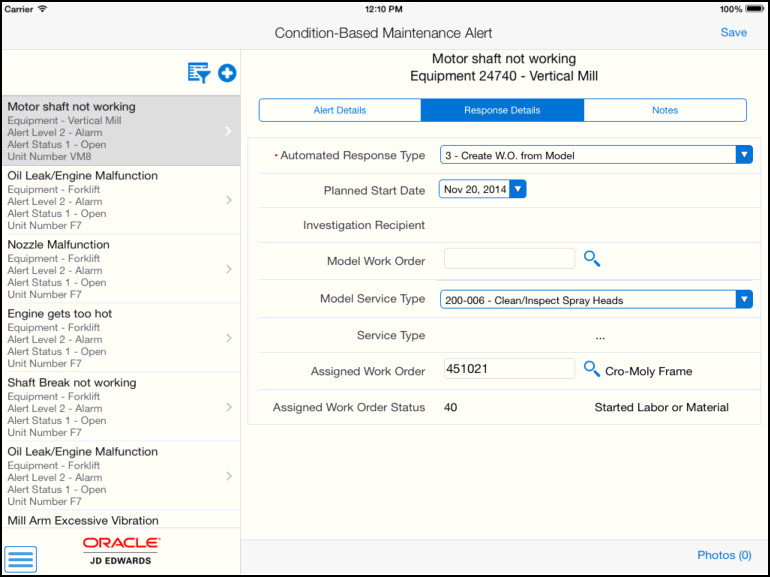
Description of ''Figure 7-2 Condition-Based Maintenance - Response Details Tab''
-
To view photos for the selected maintenance alert, tap the Photos (#) button at the bottom right. The number on the button represents the number of available photos. The application displays a list of available photos, with the first photo in the list displayed on the right of the screen. To view a different photo, tap the photo in the list.
-
To delete a photo, tap the photo you want to delete, and then tap the Delete button on the CBM Alert Photos screen.
-
To add a photo, tap the Add button on the CBM Alert Photos screen, and then select Album or Camera.
To attach an existing photo from your device's photo gallery, tap the Album option and then select the photo you want to attach. To take a new photo, tap the Camera option, and then take a new photo using the device's camera feature. On the New Photo screen, enter a name for the photo and tap the Save button.
Tap the Back button on the Photos screen to return to the Condition-Based Maintenance Alert screen.
-
Tap the Notes tab to review the existing notes, or to add new notes and tap the Save button. The new note appears at the bottom of the Notes History section after it is saved.
-
To log out of the application, tap the Menu button at the bottom left of the screen, and then tap Logout.
7.3.2 Adding Condition-Based Alerts Using ta Mobile Tablet
To add condition-based maintenance alerts:
-
Open the application by tapping the CBM Alert icon on your device, and then log in.
See Section 3, "Logging Into Mobile Enterprise Applications"
-
Tap the Add icon on the Condition-Based Maintenance Alert screen.
-
Enter the alert details on the Alert Details tab of the Condition-Based Maintenance Alert screen.
- Equipment Number (Release 9.1 Update)
-
This is a required field. Enter data in the Equipment Number field using one of these options:
-
Use the keyboard on your mobile device to manually enter the data. Alternately, you can tap the search and select button to search and select a piece of equipment.
-
Use the camera application on your mobile device to scan the data.
To use this option, tap the QR Code button next to the Equipment Number field. The system launches the device camera and you can scan the barcode of the equipment.
-
Use a Bluetooth-enabled scanning device to scan the data.
To use this option, tap the Equipment Number field to activate the scanning device. Then, scan the barcode of the equipment using the scanning device.
Note:
The Equipment Number field is designed to accept the asset that you identify with an identification symbol in the Fixed Assets Constants program (P001012).See Setting Up Fixed Asset Constants in the JD Edwards EnterpriseOne Applications Fixed Assets Implementation Guide.
For example, if the symbol to identify the serial number is "/" and the serial number is "4CE0460D0G"; then you need to enter "/4CE0460D0G" in the Equipment Number field to search and select a piece of equipment.
-
- Measurement Location and Description
-
Select a value from the Measurement Location drop-down that indicates a measurement location on a piece of equipment. You can use this code to indicate where a measurement is taken or where an alert originates from a piece of equipment.
Enter a description for measurement location in the Description field. You must enter a value in the Description field.
- Alert Level
-
Select the level for the alert from the Alert Level drop-down menu. You must select a value in this field.
- Alert Status
-
Select a status for the alert from the Alert Status drop-down menu. If you leave this field blank, the system automatically assigns an open status to the alert.
- Event Date/Time
-
Enter the date on which an event occurred, such as the date of a test reading or the date of a condition-based alarm. This is a required field.
- Send Notification Message
-
Select the radio button to specify that a notification message is sent when a condition-based alert is entered into the system. If you do not select the button, the system does not send a notification message.
The status of radio button can be populated from the processing options or from the information setup in the alert action rules.
Additionally, complete any of the remaining optional fields on the Alert Details tab, and then tap the Save button at the top right.
The system displays the Record Created message.
-
To set up alert action rules to respond to alerts automatically, tap the Response Details tab.
- Automated Response Type
-
Select a value from the drop-down menu to specify the value for the automated response type for the condition-based alert record. Based on the value you select in this field, the system activates some of the fields for user entry:
-
2: When you specify the response type 2, the device enables the Investigation Recipient field for user entry.
-
3: When you specify the response type 3, the device enables the Model Work Order and Model Service Type fields for user entry.
-
4: When you specify the response type 4, the device enables the Service Type field for user entry.
Note:
You must enter values in the fields that the device enables based on the response type that you select.Figure 7-3 Condition- Based Maintenance - Response Details Tab

Description of ''Figure 7-3 Condition- Based Maintenance - Response Details Tab''
-
Additionally, complete any of the remaining optional fields on the Response Details tab, and then tap the Save button at the bottom right.
-
Tap the Notes tab to review notes, or add new notes to the record. To enter a new note, enter text in the New Notes section and tap the Save button. The new note appears at the bottom of the Notes History section after it is saved.
-
To add photos for the new alert, while entering details on the Alert, Response, or Notes tab, tap the Save and Add Photo button at the bottom right of the respective tab to save the record and add photos for the new alert.
Alternately, to add a photo for a new alert that is already saved, tap the Photos button at the bottom right.
-
Tap the Add button on the CBM Alert Photos screen, and then select Album or Camera.
To attach an existing photo from your device's photo gallery, tap the Album option and then select the photo you want to attach. To take a new photo, tap the Camera option, and then take a new photo using the device's camera feature. On the New Photo screen, enter a name for the photo and tap the Save button.
Tap the Back button on the Photos screen to return to the Condition-Based Maintenance Alert screen.
-
To log out of the application, tap the Menu button at the bottom left of the screen, and then tap Logout.
7.4 Using the Condition-Based Maintenance Mobile Smartphone Application
The Condition-Based Maintenance smartphone application enables you to:
-
Review condition-based alert messages.
-
Add important alert information.
-
Send notification alert messages.
-
Add or delete photos for alerts.
-
Add notes for alerts.
Before you can use the application, you must download and install the application from the application store on your device.
7.4.1 Reviewing and Updating Condition-Based Alerts Using a Mobile Smartphone
To review and update condition-based maintenance alerts:
-
Open the application by tapping the CBM Alert icon on your device, and then log in.
See Chapter 3, "Logging Into Mobile Enterprise Applications"
-
The device displays the CBM Alert screen with the list of all open status alerts with details such as alert description, equipment number and description, alert level number and description, alert status and description, and unit number.
-
To narrow your search using the filter fields, tap the Filter button, and specify values in these fields on the Filters screen:
Closed Status Alerts
Technician
Customer Number
Location
Site Number
Equipment Number (Release 9.1 Update) - This field retrieves the equipment list based on the equipment number. Enter data in the Equipment Number field using one of these options:
-
Use the keyboard on your mobile device to manually enter the data. Alternately, you can tap the search and select button to search and select a piece of equipment.
-
Use the camera application on your mobile device to scan the data.
To use this option, tap the QR Code button next to the Equipment Number field. The system launches the device camera and you can scan the barcode of the equipment.
-
Use a Bluetooth-enabled scanning device to scan the data.
To use this option, tap the Equipment Number field to activate the scanning device. Then, scan the barcode of the equipment using the scanning device.
Note:
The Equipment Number field is designed to accept the asset that you identify with an identification symbol in the Fixed Assets Constants program (P001012).See Setting Up Fixed Asset Constants in the JD Edwards EnterpriseOne Applications Fixed Assets Implementation Guide.
For example, if the symbol to identify the serial number is "/" and the serial number is "4CE0460D0G"; then you need to enter "/4CE0460D0G" in the Equipment Number field to search and select a piece of equipment.
-
-
In the Filters screen, to continue the search using the specified filter values, tap the Apply button. When you tap the Apply button, the device:
-
Takes you to the Condition-Based Maintenance Alert screen associated with the last saved filter values, if applicable.
-
Ignores the filter values that you entered, and restores the last saved filter values to the filter fields.
To discontinue the use of filter values in your search, tap the Cancel button. When you tap the Cancel button, the device:
-
Takes you to the Condition-Based Maintenance Alert screen associated with the last saved filter values, if applicable.
-
Ignores the filter values that you entered, and restores the last saved filter values to the filter fields.
To delete all filter values you specified, and to enter new filter values, tap the Clear button.
-
-
The system returns you to the CBM Alert screen with a list of condition-based alerts that meet your search criteria.
Tap any record in the list to review the details for that record.
-
On the Alert tab, review and modify the alert details. Tap the Save button at the top right to save any changes you make on this tab.
Figure 7-4 Condition- Based Maintenance - Alert Tab - Smartphone
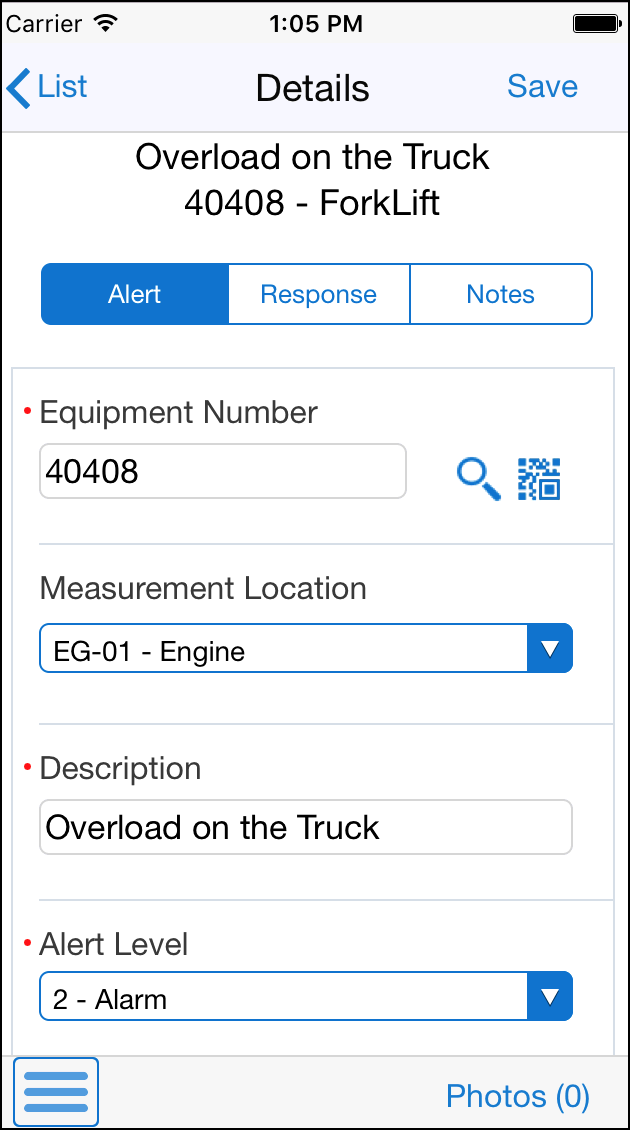
Description of ''Figure 7-4 Condition- Based Maintenance - Alert Tab - Smartphone''
-
Tap the Response tab to review or update response details for the alert. Tap the Save button at the top right to save any changes you make on this tab.
Figure 7-5 Condition-Based Maintenance - Response Tab - Smartphone
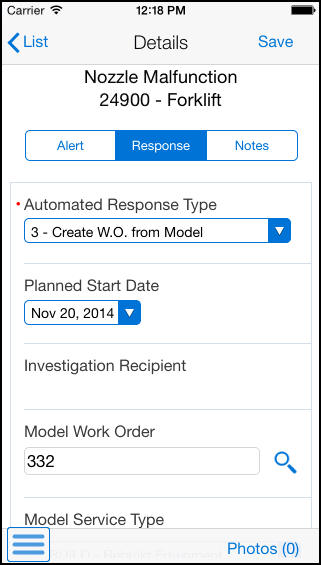
Description of ''Figure 7-5 Condition-Based Maintenance - Response Tab - Smartphone''
-
Tap the Notes tab to review the existing notes, or to add new notes and tap the Save button. The new note appears at the bottom of the Notes History section after it is saved.
-
To view photos for the selected alert, tap the Photos (#) button at the bottom right. The number on the button represents the number of available photos. The application displays a list of available photos. Tap the photo you want to view.
-
To delete a photo, tap the photo you want to delete, and then tap the Delete button.
-
To add a photo, tap the Add button on the CBM Alert Photos screen, and then select Album or Camera.
To attach an existing photo from your device's photo gallery, tap the Album option and then select the photo you want to attach. To take a new photo, tap the Camera option, and then take a new photo using the device's camera feature. On the New Photo screen, enter a name for the photo and tap the Save button.
Tap the Back button on the CBM Alert Photos screen.
-
To log out of the application, tap the Menu button at the bottom left of the screen, and then tap Logout.
7.4.2 Adding Condition-Based Alerts Using a Mobile Smartphone
To add condition-based maintenance alerts:
-
Open the application by tapping the CBM Alert icon on your device, and then log in.
See Chapter 3, "Logging Into Mobile Enterprise Applications"
-
Tap the Add icon on the CBM Alert screen.
-
Enter the alert details on the Alert tab of the Details screen.
- Equipment Number (Release 9.1 Update)
-
This is a required field. Enter data in the Equipment Number field using one of these options:
-
Use the keyboard on your mobile device to manually enter the data. Alternately, you can tap the search and select button to search and select a piece of equipment.
-
Use the camera application on your mobile device to scan the data.
To use this option, tap the QR Code button next to the Equipment Number field. The system launches the device camera and you can scan the barcode of the equipment.
-
Use a Bluetooth-enabled scanning device to scan the data.
To use this option, tap the Equipment Number field to activate the scanning device. Then, scan the barcode of the equipment using the scanning device.
Note:
The Equipment Number field is designed to accept the asset that you identify with an identification symbol in the Fixed Assets Constants program (P001012).See Setting Up Fixed Asset Constants in the JD Edwards EnterpriseOne Applications Fixed Assets Implementation Guide.
For example, if the symbol to identify the serial number is "/" and the serial number is "4CE0460D0G"; then you need to enter "/4CE0460D0G" in the Equipment Number field to search and select a piece of equipment.
-
- Measurement Location and Description
-
Select a value from the Measurement Location drop-down that indicates a measurement location on a piece of equipment. You can use this code to indicate where a measurement is taken or where an alert originates from a piece of equipment.
Enter a description for measurement location in the Description field. You must enter a value in the Description field.
- Alert Level
-
Select a level for the alert from the Alert Level drop-down menu. You must select a value in this field.
- Alert Status
-
Select a status for the alert from the Alert Status drop-down menu. If you leave this field blank, the system automatically assigns an open status to the alert.
- Event Date/Time
-
Enter the date on which an event occurred, such as the date of a test reading or the date of a condition-based alarm. This is a required field.
- Send Notification Message
-
Select the radio button to specify that a notification message is sent when a condition-based alert is entered into the system. If you do not select the button, the system does not send a notification message.
The status of radio button can be populated from the processing options or from the information setup in the alert action rules.
Additionally, complete any of the remaining optional fields on the Alert tab, and then tap the Save button at the top right.
Figure 7-6 Add Condition- Based Maintenance Smartphone - Alert tab
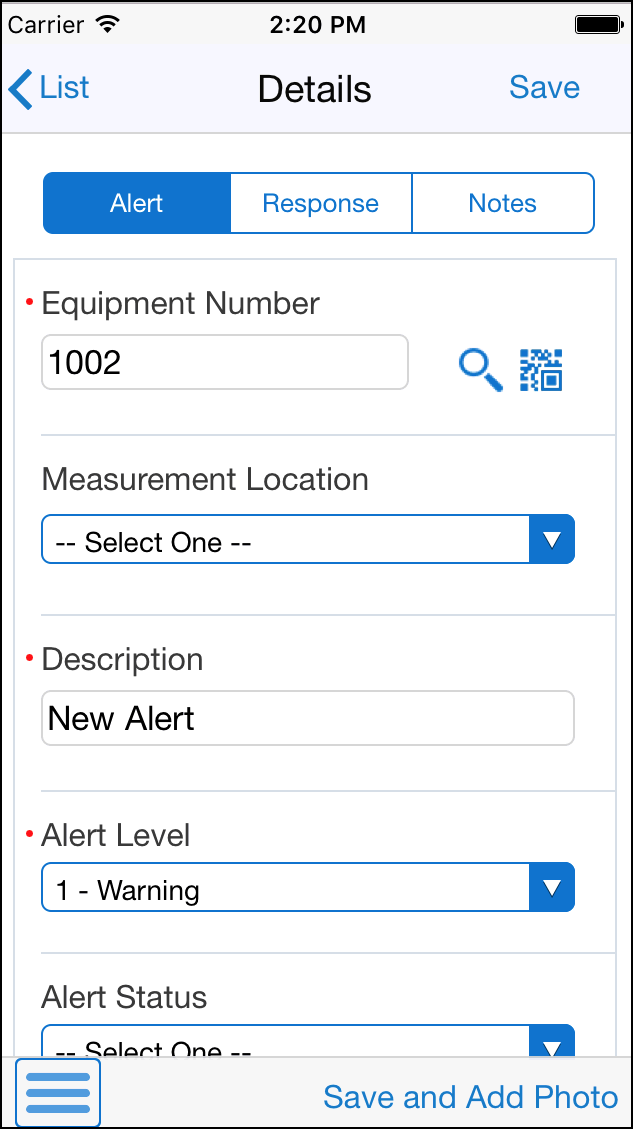
Description of ''Figure 7-6 Add Condition- Based Maintenance Smartphone - Alert tab''
-
To set up alert action rules to respond to alerts automatically, tap the Response tab.
- Automated Response Type
-
Select a value from the drop-down menu to specify the value for the automated response type for the condition-based alert record. Based on the value you select in this field, the device activates some of the fields for user entry:
-
2: When you specify the response type 2, the device enables the Investigation Recipient field for user entry.
-
3: When you specify the response type 3, the device enables the Model Work Order and Model Service Type fields.
-
4: When you specify the response type 4, the device enables the Service Type field for user entry.
Note:
You must enter values in the fields that the device enables based on the response type that you select. -
Additionally, complete any of the remaining optional fields on the Response tab, and then tap the Save button at the top right.
Figure 7-7 Add Condition- Based Maintenance Smartphone - Response tab
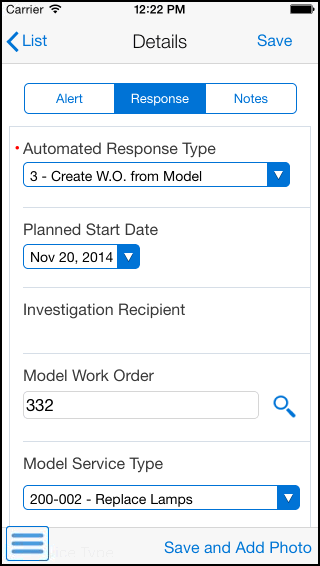
Description of ''Figure 7-7 Add Condition- Based Maintenance Smartphone - Response tab''
When you save a new alert, the device displays the CBM Alert screen with the new alert displayed on the top of the list of alerts.
-
Tap the Notes tab to add new notes to the record. To enter a new note, enter text in the New Notes section and tap the Save button. The new note appears at the bottom of the Notes History section after it is saved.
-
To add photos for the new alert, while entering details on the Alert, Response, or Notes tab, tap the Save and Add Photo button at the bottom right of the respective tab to save the record and add photos for the new alert.
-
Tap the Add button on the CBM Alert Photos screen, and then select Album or Camera.
To attach an existing photo from your device's photo gallery, tap the Album option and then select the photo you want to attach. To take a new photo, tap the Camera option, and then take a new photo using the device's camera feature. On the New Photo screen, enter a name for the photo and tap the Save button.
Tap the Back button on the Photos screen to return to the CBM Alert screen.
-
To log out of the application, tap the Menu button at the bottom left of the screen, and then tap Logout.